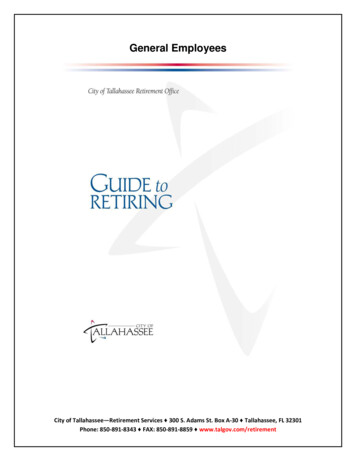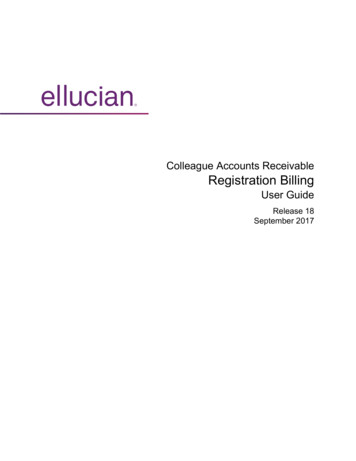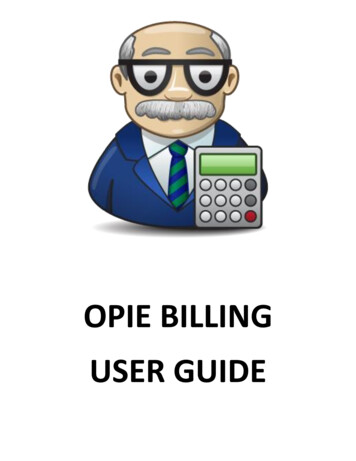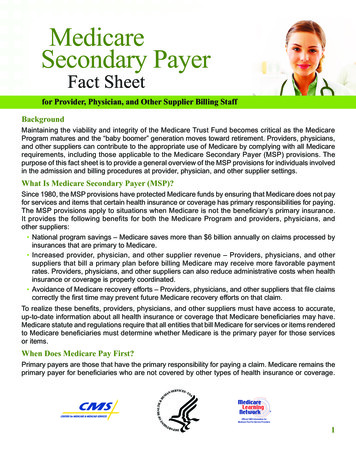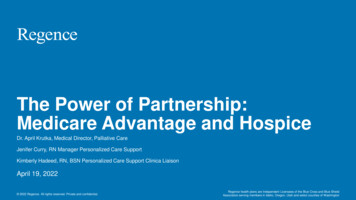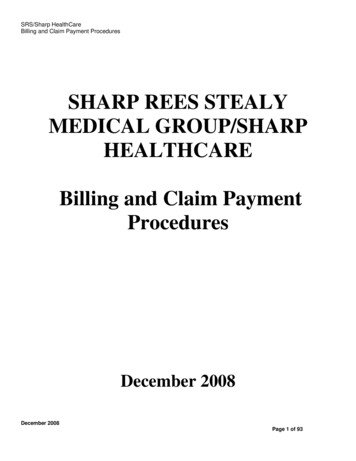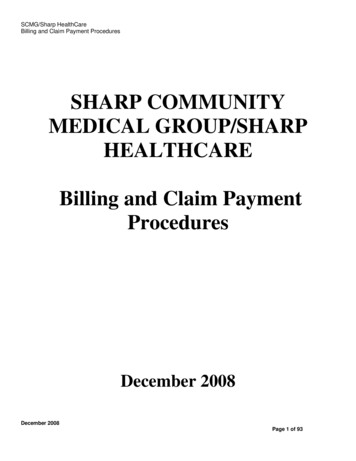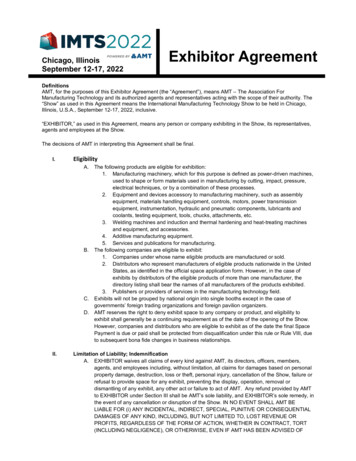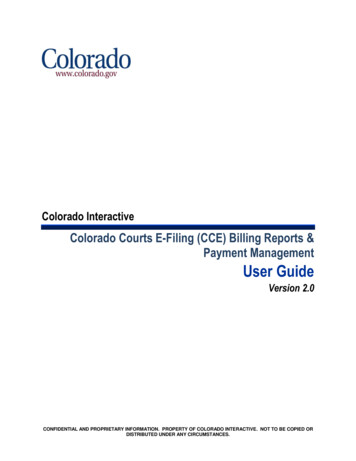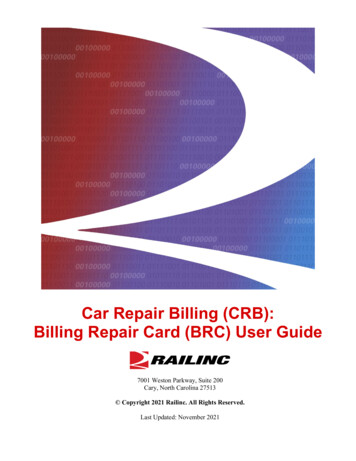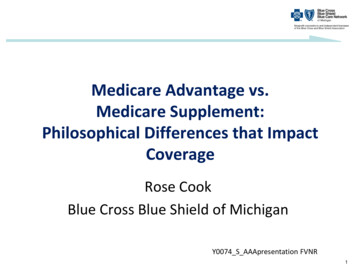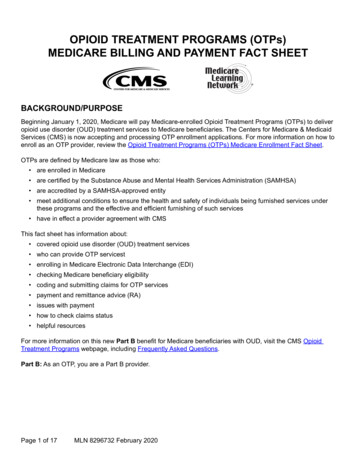
Transcription
OPIOID TREATMENT PROGRAMS (OTPs)MEDICARE BILLING AND PAYMENT FACT SHEETBACKGROUND/PURPOSEBeginning January 1, 2020, Medicare will pay Medicare-enrolled Opioid Treatment Programs (OTPs) to deliveropioid use disorder (OUD) treatment services to Medicare beneficiaries. The Centers for Medicare & MedicaidServices (CMS) is now accepting and processing OTP enrollment applications. For more information on how toenroll as an OTP provider, review the Opioid Treatment Programs (OTPs) Medicare Enrollment Fact Sheet.OTPs are defined by Medicare law as those who: are enrolled in Medicare are certified by the Substance Abuse and Mental Health Services Administration (SAMHSA) are accredited by a SAMHSA-approved entity meet additional conditions to ensure the health and safety of individuals being furnished services underthese programs and the effective and efficient furnishing of such services have in effect a provider agreement with CMSThis fact sheet has information about: covered opioid use disorder (OUD) treatment services who can provide OTP servicest enrolling in Medicare Electronic Data Interchange (EDI) checking Medicare beneficiary eligibility coding and submitting claims for OTP services payment and remittance advice (RA) issues with payment how to check claims status helpful resourcesFor more information on this new Part B benefit for Medicare beneficiaries with OUD, visit the CMS OpioidTreatment Programs webpage, including Frequently Asked Questions.Part B: As an OTP, you are a Part B provider.Page 1 of 17MLN 8296732 February 2020
Opioid Treatment Programs (OTPs) MedicareBilling and Payment Fact SheetMLN Fact SheetCOVERED OPIOID USE DISORDER (OUD) TREATMENT SERVICESCovered opioid use disorder treatment services include: FDA-approved opioid agonist and antagonist treatment medications dispensing and administering medications (if applicable) substance use disorder counseling individual and group therapy toxicology testing intake activities periodic assessmentsWho can Provide OTP Services?OTP providers must be: enrolled in Medicare fully certified by SAMHSA accredited by an accrediting body approved by SAMHSA able to meet such additional conditions as the Secretary may find necessary to ensure the health andsafety of individuals being provided servicesProfessionals who can provide the substance use counseling and individual and group therapy included in thebundled payment may include: licensed clinical social workers licensed professional counselors licensed clinical alcohol and drug counselors certified peer specialists who are permitted to furnish this type of therapy or counseling by state law andscope of practice others who are permitted to furnish this type of therapy or counseling by state law and scope of practiceIf the individuals furnishing therapy or counseling services are not authorized under state law to furnish suchservices, the therapy or counseling services provided by these professionals would not be covered as OUDtreatment services.Overview of OTP Billing/Payment Process Enroll in Medicare EDI Check Medicare Beneficiary Eligibility Code for OTP Services Submit Claims to MAC or Billing Agent Check Claims Status Receive Payment by EFT Receive Electronic Remit Advice or Standard Paper RemitPage 2 of 17MLN 8296732 February 2020
Opioid Treatment Programs (OTPs) MedicareBilling and Payment Fact SheetMLN Fact SheetENROLLING IN MEDICARE EDIEDI transactions allow you to submit transactions and get payment faster at a lower cost than using paper ormanual transactions.After you enroll in Medicare, your Medicare Administrative Contractor (MAC) will give you information aboutenrolling in EDI. Each MAC has different instructions and methods for submitting EDI enrollment applications.Read your enrollment approval letter carefully and check your MAC’s website(s) for instructions. Rememberthat you must complete the EDI enrollment process with each MAC to which you submit claims.OTP providers must complete the EDI Registration Form and EDI Enrollment Form before you can submitelectronic media claims (EMC) or other EDI transactions to Medicare. While each MAC’s EDI enrollmentapplication submission process may vary, OTP providers must give identifying information about theprovider(s) who will submit electronic data.OTPs who intend to submit EMC or use EDI, either directly with Medicare or through a billing service orclearinghouse, must complete the forms. Each new EMC biller must sign and submit the forms to theirMAC(s) as instructed. An OTP organization with multiple Medicare provider numbers can complete a singleEDI Enrollment Form on behalf of the organizational components. For more information about the EDI forms,contact your MAC.After you complete EDI enrollment, your EDI contractor will help you with connectivity, system access numbersand passwords, and testing your EDI format transmissions. MACs have EDI helplines to help you.Helpful Resources Medicare Parts A/B and DME EDI Help Lines Medicare Claims Processing Manual (Pub.100-04), Chapter 24 Electronic Billing & EDI Transactions webpageCHECKING MEDICARE BENEFICIARY ELIGIBILITY FOR OTP SERVICESWhen you schedule appointments for Medicare beneficiaries, remind them to bring to their appointment allhealth insurance cards showing their health insurance coverage. This will help you determine who to billfor services, and give you the correct spelling of your Medicare patients’ first and last names and Medicarebeneficiary identifiers.If your patient has Medicare coverage but does not have a Medicare Health Insurance card, encourage yourpatient to log into mymedicare.gov or call 1-800-MEDICARE (or 1-800-833-4455 if your patient gets benefitsunder the Railroad Retirement Board) to get a replacement Medicare Health Insurance card.You can check your patient’s Medicare eligibility in one of four ways:1. Your vendor or clearinghouse can give you access to eligibility information for Medicare and other payers2. Your IT department can help you access eligibility information directly from CMS through the HIPAAEligibility Transaction System (HETS)3. Your MAC portals provide eligibility information4. You can also use the MACs Interactive Voice Response (IVR) systemsPage 3 of 17MLN 8296732 February 2020
Opioid Treatment Programs (OTPs) MedicareBilling and Payment Fact SheetMLN Fact SheetYou must have the following information to run an eligibility search: patient’s Medicare beneficiary identifier(Medicare number), patient’s full first and last name, and patient’s date of birth.You will get a basic set of eligibility information if your patient is entitled to Part A and/or Part B including: Medicare beneficiary demographics Part A and B entitlement including any periods of inactivity coverage status of requested and supported Service Type Codes (STCs) Medicare Secondary Payer (MSP), Medicare Advantage (MA), and Part D plan enrollment information(where applicable) deductible remainingFor more detailed information on this process, review the CMS HETS 270/271 5010 Companion Guide,Section 7.2 General Transaction Notes.If you already check eligibility electronically for another payer, work with your vendor to get access to Medicareinformation.How to Reach the HETS Help DeskThe HETS Desktop (HDT) Help Desk is open Monday through Friday from 7 am to 7 pm, Eastern StandardTime (EST). Contact the HDT Help Desk by: email at mcare@cms.hhs.gov or phone at 1-866-324-7315.For more information, visit the HETS Help Desk webpage.CODING AND BILLING FOR OTP SERVICESStarting January 1, 2020, CMS pays for the overall treatment of OUD. Any beneficiary with OUD is eligible forthese services.There are 14 billable OTP-only HCPCS G-codes (G2067 through G2080) for opioid treatment serviceson Medicare Part B claims. Only OTPs can bill Medicare using the specific codes for OTP services. Noother provider or supplier type except for an OTP can bill for OTP services (billed using HPCS codesG2067-G2080). However, the CY2020 Physician Fee Schedule includes bundled payment codes (billedusing HCPCS codes G2086-G2088) and payment rates for an episode of opioid use disorder (OUD)treatment furnished by physicians and other practitioners in the office setting.Only OTPs can submit claims with codes G2067 through G2080.Coding for Medication Assisted Treatment (MAT) and Add-On CodesThe threshold for billing the codes describing weekly episodes (HCPCS codes G2067-G2075) is the delivery ofat least one service in the weekly bundle (from either the drug or non-drug component).The threshold to bill a full episode is that at least one service is furnished (from either the drug or non-drugcomponent) to the patient during the week that corresponds to the episode of care. If no drug was provided tothe patient during that episode, the OTP must bill the G-code describing a weekly bundle not including the drug(HCPCS code G2074) and the threshold to bill would be at least one service in the non-drug component. If adrug was provided with or without additional non-drug component services, the appropriate G-code describingthe weekly bundle that includes the drug furnished may be billed.Page 4 of 17MLN 8296732 February 2020
Opioid Treatment Programs (OTPs) MedicareBilling and Payment Fact SheetMLN Fact SheetCMS established G-codes describing treatment with: Methadone (G2067) Buprenorphine oral (G2068) Buprenorphine injectable (G2069) Buprenorphine implants (insertion, removal, and insertion/removal) (G2070 and G2072) Extended-release, injectable naltrexone (G2073) Non-drug bundle (G2074) Bill for services furnished during an episode of care when a medication is not administered Example: For example, in the case of a patient receiving injectable buprenorphine, we wouldexpect that OTPs would bill HCPCS code G2069 for the week during which the injection wasadministered and you would bill HCPCS code G2074, which describes a bundle not includingthe drug, during any subsequent weeks when you furnish at least one non-drug service until youadminister the injection again, at which time, you would bill HCPCS code G2069 again for thatweek. Medication not otherwise specified (G2075) Use when you give Medication Assisted Treatment (MAT) services with a new opioid agonist orantagonist treatment medication approved by the FDA under Section 505 of the United StatesFederal Food, Drug, and Cosmetic (FFDCA) for the treatment of OUD All of the drugs that are FDA-approved for the treatment of OUD are currently covered by HCPCScodes G2067-G2073.Additionally, CMS established add-on G-codes for: intake activities (G2076) periodic assessments (G2077) take-home supplies of methadone (G2078) and take home supplies of oral buprenorphine (G2079) additional counseling furnished (G2080)CMS uses the typical or average maintenance dose to determine drug costs for each of the bundles.CMS assigned flat dollar payment amounts for the codes describing the OTP bundled services (HCPCS codesG2067-G2080). See Table 18 of the Final Rule (CMS-1715-F and IFC).Note: as an OTP provider, you must use only the codes describing bundled payments; do not use other codes,such as those paid under the Physician Fee Schedule (PFS). Only Medicare-enrolled OTPs can bill for HCPCScodes G2067-G2080.These rates listed below represent base rates. Please visit the OTP Billing/Payment webpage for locality rates.Page 5 of 17MLN 8296732 February 2020
Opioid Treatment Programs (OTPs) MedicareBilling and Payment Fact SheetMLN Fact SheetMAT Codes, Descriptors, and National Medicare Payment RatesNOTE: Use the In the Locality Key document to find the locality and corresponding MAC numbers assigned toyour OTP based on the State/Fee Schedule Area/County location of your practice.Use the Locality Adjusted Rates document to find your locality and corresponding MAC numbers and then usethe HCPCS code to find the geographically-adjusted payment rate.G CODESHCPCScode G2067HCPCScode G2068HCPCScode G2069HCPCScode G2070HCPCScode G2071Page 6 of 17DESCRIPTORS FOR OTP BUNDLED SERVICESMedication assisted treatment, methadone; weeklybundle including dispensing and/or administration,substance use counseling, individual and grouptherapy, and toxicology testing, if performed (provisionof the services by a Medicare-enrolled OpioidTreatment Program).Medication assisted treatment, buprenorphine(oral); weekly bundle including dispensing and/oradministration, substance use counseling, individualand group therapy, and toxicology testing if performed(provision of the services by a Medicare-enrolledOpioid Treatment Program).Medication assisted treatment, buprenorphine(injectable); weekly bundle including dispensing and/or administration, substance use counseling, individualand group therapy, and toxicology testing if performed(provision of the services by a Medicare-enrolledOpioid Treatment Program).Medication assisted treatment, buprenorphine (implantinsertion); weekly bundle including dispensing and/oradministration, substance use counseling, individualand group therapy, and toxicology testing if performed(provision of the services by a Medicare-enrolledOpioid Treatment Program).Medication assisted treatment, buprenorphine (implantremoval); weekly bundle including dispensing and/oradministration, substance use counseling, individualand group therapy, and toxicology testing if performed(provision of the services by a Medicare-enrolledOpioid Treatment Program).MLN 8296732 February 2020DRUGCOSTNONDRUGCOSTTOTALCOST 35.28 172.21 207.49 86.26 172.21 258.47 1,578.64 178.65 1,757.29 4,918.98 407.86 5,326.84 0 427.32 427.32
Opioid Treatment Programs (OTPs) MedicareBilling and Payment Fact SheetG CODESHCPCScode G2072HCPCScode G2073HCPCScode G2074HCPCScode G2075Page 7 of 17MLN Fact SheetDESCRIPTORS FOR OTP BUNDLED SERVICESMedication assisted treatment, buprenorphine(implant insertion and removal); weekly bundleincluding dispensing and/or administration, substanceuse counseling, individual and group therapy, andtoxicology testing if performed (provision of theservices by a Medicare-enrolled Opioid TreatmentProgram).Medication assisted treatment, naltrexone; weeklybundle including dispensing and/or administration,substance use counseling, individual and grouptherapy, and toxicology testing if performed (provisionof the services by a Medicare-enrolled OpioidTreatment Program).Medication assisted treatment, weekly bundle notincluding the drug, including substance use counseling,individual and group therapy, and toxicology testing ifperformed (provision of the services by a Medicareenrolled Opioid Treatment Program).Medication assisted treatment, medication nototherwise specified; weekly bundle includingdispensing and/or administration, substance usecounseling, individual and group therapy, andtoxicology testing, if performed (provision of theservices by a Medicare-enrolled Opioid TreatmentProgram); partial episode.MLN 8296732 February 2020NONDRUGCOSTDRUGCOSTTOTALCOST 4,918.98 626.97 5,545.95 1,164.02 178.65 1,342.67 0 161.71 161.71---
Opioid Treatment Programs (OTPs) MedicareBilling and Payment Fact SheetG CODESMLN Fact SheetNONDRUGCOSTDRUGCOSTDESCRIPTORS FOR OTP BUNDLED SERVICESTOTALCOSTINTENSITY ADD-ON CODESHCPCScode G2076HCPCScode G2077HCPCScode G2078HCPCScode G2079HCPCScode G2080Page 8 of 17Intake activities, including initial medical examinationthat is a complete, fully documented physicalevaluation and initial assessment conducted bya program physician or a primary care physician, or anauthorizedhealthcare professional under the supervision of aprogram physician or qualified personnel that includespreparation of a treatment plan that includes thepatient’s short-term goals and the tasks the patientmustperform to complete the short-term goals; the patient’srequirements for education, vocational rehabilitation,and employment; and the medical,psycho- social, economic, legal, or other supportiveservices that a patient needs, conducted by qualifiedpersonnel (provision of the services by a Medicareenrolled Opioid Treatment Program); List separately inaddition to code for primary procedure.Periodic assessment; assessing periodically byqualified personnel to determine the most appropriatecombination of services and treatment (provision ofthe services by a Medicare-enrolled Opioid TreatmentProgram); List separately in addition to code forprimary procedure.Take-home supply of methadone; up to 7 additionalday supply (provision of the services by a Medicareenrolled Opioid Treatment Program); List separately inaddition to code for primary procedure.Take-home supply of buprenorphine (oral); up to 7additional day supply (provision of the services by aMedicare-enrolled Opioid Treatment Program); Listseparately in addition to code for primary procedure.Each additional 30 minutes of counseling in a weekof medication assisted treatment, (provision of theservices by a Medicare-enrolled Opioid TreatmentProgram); List separately in addition to code forprimary procedure.MLN 8296732 February 2020 0 179.46 179.46 0 110.28 110.28 35.28 0 35.28 86.26 0 86.26 0 30.94 30.94
Opioid Treatment Programs (OTPs) MedicareBilling and Payment Fact SheetMLN Fact SheetFrequency of Use and Other Billing GuidelinesThe following rules apply to how often the OTP G-Codes can be billed: HCPCS codes G2067 - G2075 cover episodes of care of 7 contiguous days and cannot be billed for thesame patient more than once per 7 contiguous day period. Some of the bundled payment codes describe a drug that is typically only administered once per month,such as the injectable drugs, or once in a 6-month period, in the case of the buprenorphine implants. Consistent with FDA labeling: HCPCS codes G2069 and G2073 should generally not be used more than once every 4 weeks HCPCS codes G2070 and G2072 should generally not be used more than once every 6 months Patients may be appropriately given OUD services at more than one OTP within a 7 day period in certainlimited clinical situations, such as for guest dosing or when a patient transfers care between OTPs. Eachof the involved OTPs may bill the appropriate HCPCS codes for the services given to the patient, but bothOTPs must maintain sufficient medical record documentation to reflect the clinical situation and servicesprovided. In instances in which a patient is switching from one drug to another, the OTP should only bill for onecode describing a weekly bundled payment for that week and should determine which code to bill basedon which drug was furnished for the majority of the week. The add-on code describing intake activities (HCPCS code G2076) should only be billed for new patients(that is, patients starting treatment at the OTP) There are two add-on codes that describe take-home doses of medication, one for take-home suppliesof methadone (HCPCS code G2078), which describes up to 7 additional days of medication, and canbe billed along with the respective weekly bundled payment in units of up to 3 (for a total of up to a onemonth supply), and one for take-home supplies of oral buprenorphine (HCPCS code G2079), whichalso describes up to 7 additional days of medication and can be billed along with the base bundle inunits of up to 3 (for a total of up to a 1 month supply). SAMHSA allows a maximum take-home supply ofone month of medication; therefore, we do not expect the add-on codes describing take-home doses ofmethadone and oral buprenorphine to be billed any more than 3 times in one month (in addition to theweekly bundled payment). The add-on code for take-home doses of methadone can only be used withthe methadone weekly episode of care code (HCPCS code G2067). Similarly, the add-on code for takehome doses of oral buprenorphine can only be used with the oral buprenorphine weekly episode of carecode (HCPCS code G2068). HCPCS code G2080 may be billed when counseling or therapy services are furnished that substantiallyexceed the amount specified in the patient’s individualized treatment plan. OTPs are required todocument the medical necessity for these services in the patient’s medical record.Page 9 of 17MLN 8296732 February 2020
Opioid Treatment Programs (OTPs) MedicareBilling and Payment Fact SheetMLN Fact SheetSUBMITTING CLAIMS TO YOUR MAC OR BILLING AGENTAs an OTP provider, you must submit all claims to your MAC or billing agency/agent. You must use the 837Ptransaction to transmit health care claims electronically, or use the CMS-1500 (the paper version of the 837P)and mail it to your MAC.98 percent of Medicare FFS providers/suppliers submit their claims electronically for a faster processing time.You must get an exception to file using paper claims.Include the following information on each claim form:A. Healthcare Common Procedure Coding System (HCPCS) codes associated with the OTP serviceB. The OTP’s NPI in the Rendering Provider Identifier section in block 24J of the CMS-1500 or its electronicequivalent. OTPs should list the prescribing or medication ordering physician’s or other eligibleprofessional’s National Provider Identifier in Field 17 (the ordering/referring/other field) of the FormCMS–1500 (Health AInsurance Claim Form; 0938–1197) or the electronic equivalent thereofC. Your organizational NPI as the Billing Provider in block 33 of the CMS-1500 or its electronic equivalentFor an explanation of HCPCS codes, visit the HCPCS Coding Questions webpage.ABC1. Files claims as soon as possible. Medicare claims must be filed to the appropriate MAC no later than 12months, or 1 calendar year, after the date of service. Your claim will be denied if you file it 12 months orlater after the date of service.2. The new POS code 58 is for non-residential opioid treatment facilities.Page 10 of 17MLN 8296732 February 2020
Opioid Treatment Programs (OTPs) MedicareBilling and Payment Fact SheetMLN Fact SheetD. Beneficiary first name, last name, and Medicare beneficiary identifierSocial Security Numbers (SSNs) are no longer used on Medicare cards. Every person with Medicare has beenassigned a Medicare Beneficiary Identifier (MBI) and has been issued a new Medicare card. The SSN-basedHICN on Medicare cards can still be used through the end of the transition period (December 31, 2019).Starting January 1, 2020, you MUST submit claims using MBIs.DE. Diagnosis or nature of illness or injury International Classification of Diseases, 10th Revision (ICD-10)diagnosis codeF. Place of Service (POS) code 58 in block 24B in the Physician or Supplier information section of the claimform to indicate a Non-residential Opioid Treatment FacilityEFOnly use the new POS code 58 for nonresidential opioid treatment facilities on OTP claims.Page 11 of 17MLN 8296732 February 2020
Opioid Treatment Programs (OTPs) MedicareBilling and Payment Fact SheetMLN Fact SheetDate of ServiceFor the codes that describe a weekly bundle (HCPCS codes G2067-G2075), one week is defined as 7contiguous days. OTPs may choose to apply a standard billing cycle by setting a particular day of the weekto begin all episodes of care. In this case, the date of service would be the first day of the OTP’s billing cycle.If a beneficiary starts treatment at the OTP on a day that is in the middle of the OTP’s standard weekly billingcycle, the OTP may still bill the applicable code for that episode of care provided that the threshold to bill forthe code has been met.Alternatively, OTPs may choose to adopt weekly billing cycles that vary across patients. Under this approach,the initial date of service will depend upon the day of the week when the patient was first admitted to theprogram or when Medicare billing began. Therefore, under this approach of adopting weekly billing cycles thatvary across patients, when a patient is beginning treatment or re-starting treatment after a break in treatment,the date of service would reflect the first day the patient was seen and the date of service for subsequentconsecutive episodes of care would be the first day after the previous 7-day period ends.For the codes describing add-on services (HCPCS codes G2076-G2080), the date of service should reflect thedate that service was furnished; however, if the OTP has chosen to apply a standard weekly billing cycle, thedate of service for codes describing add-on services may be the same as the first day in the weeklybilling cycle.For general billing requirements, review the Medicare Claims Processing Manual, Chapter 1. For more detailedinformation on completing the Form CMS-1500, review the Medicare Claims Processing Manual, Chapter 26.Helpful Resources Medicare Basics: Parts A and B Claims Overview Video Medicare Claims Processing Manual, Chapter 1 Medicare Claims Processing Manual, Chapter 26 Electronic Health Care Claims webpage New Medicare Beneficiary Identifier (MBI) Get It, Use ItPAYMENT AND REMITTANCE ADVICEYou will get payments via Electronic Funds Transfer (EFT). You must complete an Electronic Funds Transfer(EFT) Authorization Agreement (Form CMS-588) as directed by your MAC.If there are no issues with the claim, you will get payment no sooner than 13 days after filing electronically(payment on the 14th day or after). For paper-based claims, you will get payment no sooner than 28 days afterfiling (payment on the 30th day or after).There is no copayment for beneficiaries for OUD treatment services; beneficiaries are responsible for the PartB deductible.After the MAC processes the claim, you or your billing agency/agent will get either an Electronic Remit Advice(ERA) or a Standard Paper Remit (SPR) with final claim and payment information. An ERA or SPR usually: includes itemized adjudication decisions about multiple claims reports the reason and value of each adjustment to the billed amount on the claimPage 12 of 17MLN 8296732 February 2020
Opioid Treatment Programs (OTPs) MedicareBilling and Payment Fact SheetMLN Fact SheetISSUES WITH PAYMENTIf there is an issue with the information included on a claim or with a beneficiary’s eligibility, the MAC mayeither: Deny the claim: You or your billing agency/agent can file an appeal if you think the claim was deniedincorrectly. Check your MAC’s website for more information on how to appeal a denied claim. Reject the claim as unable to be processed: You or your billing agency/agent must submit a newclaim.Medicare offers free software, Medicare Remit Easy Print (MREP), to read the ERA. You can view, print, andexport special reports to Excel and other applications.]CHECK CLAIMS STATUSInteractive Voice Response (IVR) SystemEach MAC has an IVR system that gives providers free access to Medicare claims information through a tollfree telephone number. You can enter data through the IVR telephone system and get information about yourclaims. Contact your MAC for information on the Provider Contact Center and IVRuser guide.For more information review the Claim Status Request and Response webpage.Customer Service Representative (CSR)Visit your MAC website for information on the Provider Contact Center only if you are unable to access claimsinformation through the IVR.MAC PortalsProviders can get claims status information for free via the MAC’s Internet-based provider portal. Contact yourMAC for portal features and access.Most MAC portals allow you to check eligibility, see the remit, possibly submit a claim. See the listing of MACProvider Portals.Health Care Claim Status Request (276 Transaction)Providers can send a Health Care Claim Status Request (276 transaction) electronically and get a HealthCare Claim Status Response (277 transaction) back from Medicare. CMS recommends the electronic 276/277process because you can automatically generate and submit 276 queries as needed, eliminating the need formanual entry of individual queries or calls to a contractor to get this information.The 277 response allows you to automatically post the status information to patient accounts, eliminatingthe need for manual data entry by provider staff members. If you don’t know your software can automaticallygenerate 276 queries or automatically post 277 responses, contact your software vendor or billing service. Visityour MAC website for more information.Page 13 of 17MLN 8296732 February 2020
Opioid Treatment Programs (OTPs) MedicareBilling and Payment Fact SheetMLN Fact SheetBILLING & PAYMENT FOR MEDICARE/MEDICAID DUAL ELIGIBLEBENEFICIARIESDually eligible individuals are those who are eligible for both Medicare and Medicaid at the same time.Along with creating the Medicare OTP benefits, the SUPPORT Act also mandates that all states cover OTPservices in their Medicaid programs effective October 2020, subject to certain exception the Secretary mayprovide. At this time, there are 42 states that cover OTP services in their Medicaid program.On January 1, 2020, Medicare became the primary payer for OTP services for dually eligible individuals whopreviously got OTPs through their Medicaid program. During this transition, Medicaid must pay for servicesdelivered to these beneficiaries by OTP providers who are not yet enrolled in Medicare but are enrolled inMedicaid, to the extent the service is covered in that state plan. The state will later recoup the Medicaidpayments made to the OTP back to the effective date of the OTP’s Medicare enrollment, and then the OTPprovider will bill Medicare for those services.For more information, see the Tip Sheet for Opioid Treatment Program Providers Serving Dually EligibleIndividuals: State Coverage of the Medicare Part B Deductible.Helpful Resources Medicare Claims Processing Manual (IOM Pub. 100-04), Chapter 1, Section 80.2.1.2 Payment FloorStandards Health Care Payment and Remittance Advice and Electronic Funds Transfer Remittance Advice Information: An Overview Professional Paper Claim Form (CMS-1500) Medicare Billing: Form CMS-1500 and the 837 Professional Medicare Billing: Form CMS-1500 and the 837 Professional Web-Based Training (WBT) course Electron
The Centers for Medicare & Medicaid . Services (CMS) is now accepting and processing OTP enrollment applications. For more information on how to enroll as an OTP provider, review the Opioid Treatment Programs (OTPs) Medicare Enrollment Fact Sheet. OTPs are defined by Medicare law as those who: are enrolled in Medicare
